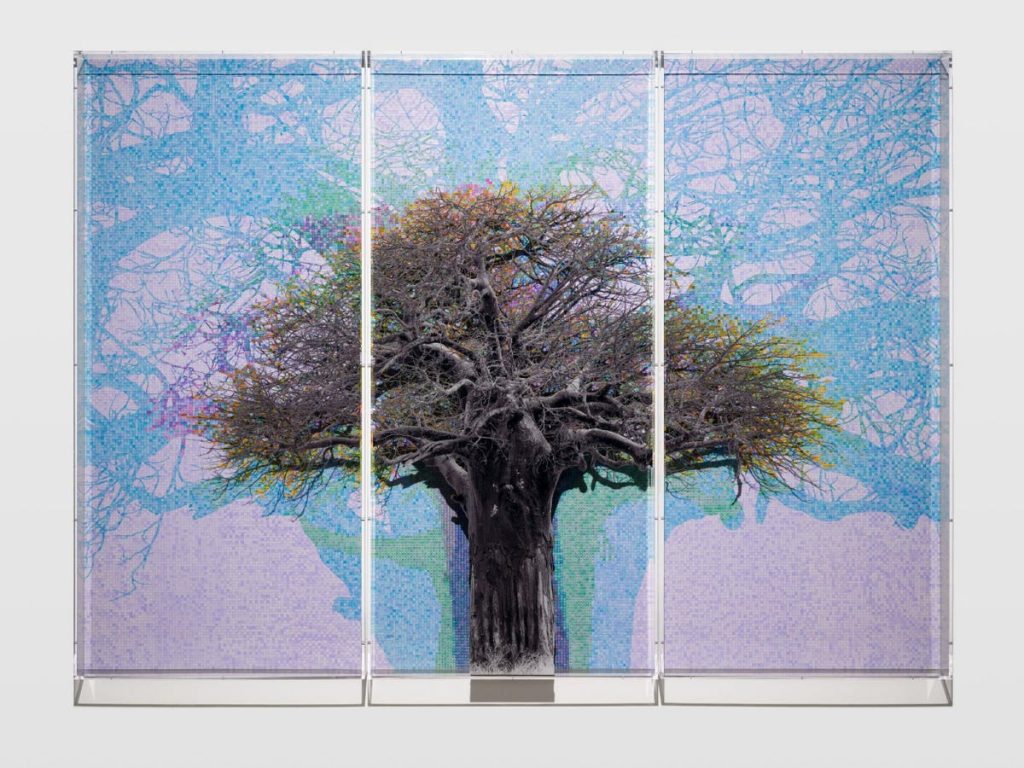Numbers and Trees: Tanzania Series 1, Baobab , Tree #4 , Maasai 2024 Acrylic sheet, acrylic paint, photograph, 3 parts 241.3 x 335.9 x 14.6 cm / 95 x 132 1/4 x 5 3/4 in
Photo: Fredrik Nilsen © Charles Gaines, Courtesy of the artist and Hauser & Wirth
Trees are having a moment. There was Richard Powers “The Overstory,” a slim novel where the point of view of a tree was as much a character as the human ones. There was Tiffany Shlain and Ken Goldberg’s recent exhibition at the Skirball (now moved on to new pastures, see here). More generally, scientists continue to explore how trees communicate with each other and the pathways they create through root networks and airborne transfers. And currently, there is Charles Gaines’ magisterial new works, Numbers and Trees, The Tanzania Baobabs, at Hauser & Wirth West Hollywood (on view through May 31, 2025).
The exhibition consists of nine large three-part images and several two part watercolors that seem to progress in complexity and across a spectrum of color. The total effect is one of amazement and awe, of beauty and calm, transporting us away from our present world and all its conflicts.
Portrait of Charles Gaines 2024
Photo: Brandon Hicks © Charles Gaines, Courtesy of the artist and Hauser & Wirth
On the evening of the exhibition’s opening, Gaines, in conversation at the gallery with LACMA curator Naima Keith and Phoenix Museum’s Olga Viso (where Gaines also currently has a retrospective) spoke of how he wanted to eliminate “the subjective in his art.”
As the exhibition press release explains, in the work on exhibit, each tree has been assigned a distinctive color and number sequence. The profusion of colors each filling a small square creates a profusion of color as unique to Gaines’ oeuvre as a Seurat pointillist masterpiece.
The use of numbers and grids for image creation is, in one sense, an artist-created artificial intelligence that can generate an endless series of possible colors and images but that is, nonetheless, tightly controlled by Gaines’ system. At the same, this method creates a distancing between the work and the viewer, a gap if you will, expressed as well by the separation in these works between the plexiglass and the photo behind it.
Numbers and Trees: Tanzania Series 1, Baobab, Tree #5, Rangi 2024 Acrylic sheet, acrylic paint, photograph, 3 parts 241.3 x 335.9 x 14.6 cm / 95 x 132 1/4 x 5 3/4 in
Photo: Fredrik Nilsen © Charles Gaines, Courtesy of the artist and Hauser & Wirth
In some of the works, the photo of the African landscape appears in the background while the color simulacrum appears in the foreground. In others, the Tree is in the foreground while there is a blown-up section of the branch architecture, what Gaines calls “an explosion.”
Gaines is now eighty, and his demeanor, as much as his work, remains thoughtful and quiet. Gaines’ flight from the subjective does not mean, as some critics believe, an avoidance of the personal, or even the political. This exhibition puts that notion to rest.
Installation view, ‘Charles Gaines. Numbers and Trees, The Tanzania Baobabs,’ Hauser & Wirth West Hollywood, February 19 – May 24. 2024
Photo: Keith Lubow © Charles Gaines, Courtesy of the artist and Hauser & Wirth
With the new work, one might ask: Why travel to Tanzania to take a photo? The exhibition press release tell us, “With Numbers and Trees, The Tanzania Baobabs, Gaines reflects on… the country’s historical context, particularly in relation to the colonial enterprise, slave trade and personal identity.” That is about as personal and political as it can get.
The baobab tree is called “The Tree of Life” because it survives in arid areas where other trees do not. Its tangled network of branches extends into the sky, as if it were upside-down, its roots visible to all.
“Gaines’ argument,” the press release notes, “that aesthetic experience is not transcendent but rather firmly rooted in and shaped by culture” explains how the Tanzanian baobab and its numeric colored equivalents are Gaines’ objective (not subjective) meditation on his roots, his personal and artistic history. Like the baobab, it is a display of Gaines’ own rootedness, and how Numbers and Trees make connections to his personal history, to art history, to other artists, and to all who experience the work.

